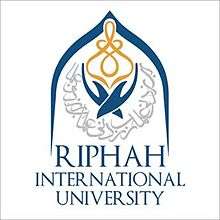Riphah International University
| Riphah Madrassa | |
 | |
| Established | 1995 |
|---|---|
| Chancellor | Maj.Gen M.Zulfiqar ali khan (R) |
| President | Dr. Anis Ahmad |
| Vice-Chancellor | Dr. Anis Ahmad |
| Students | 6000 |
| Location |
Islamabad, |
| Campus | urban |
| Colours | Blue, White |
| Nickname | riphah |
| Affiliations | HEC |
| Website |
www |
Riphah International University (Riphah) (رفاہ انٹرنیشنل یونیورسٹی) is a private University, chartered by the Federal Government of Pakistan in 2002. The University was established with a view to produce professionals with Islamic moral and ethical values. It is sponsored by a not-for-profit trust; namely Islamic International Medical College Trust (IIMCT), created in 1995. The first project of the IIMCT was the Islamic International Medical College, Rawalpindi, established in 1996 by its Founding Managing Trustee; Maj. Gen. (Retd.) Muhammad Zulfiqar Ali Khan, TI(M), TBt. Currently the University has fourteen constituent units and an overseas project, namely, RAK College of Dental Sciences, UAE. The University is also working on establishment of its campus in Mauritius.
Governance
The Honorable President of Islamic Republic of Pakistan is the Patron of the University. Maj. Gen. (Retd.) Muhammad Zulfiqar Ali Khan is the Founding Chancellor and Mr. Hassan Muhammad Khan is the Pro Chancellor of the University. Prof. Dr. Anis Ahmad, an eminent scholar of international repute and educationist of distinction, is the Founding Vice Chancellor of the University. The Board of Governors and the Academic Council are the highest policy making bodies of the University. The Vice Chancellor is the Chief Executive and Academic Officer of the University.
Campuses
Following are the constituent campuses of the university:
- Main Campus, Sector I-14, Islamabad
- City Campus - I, G-7/4, 7th Avenue, Islamabad
- City Campus - II, Evacuee Trust Complex, Islamabad
- WISH Campus, H-8, Islamabad
- Al-Mizan Campus, Rawalpindi
- Lahore City Campus, Township, Lahore
- Raiwind Road Campus, Lahore
- Riphah International University Faisalabad
- RAK College of Dental Sciences, Ras Al-Khaimah, UAE
Faculties
The university consists of several colleges with undergraduate, graduate, and postgraduate programmes:
- Islamic International Dental College
- Islamic International Engineering College
- Islamic International Medical College
- Riphah College of Rehabilitation Sciences
- Riphah Institute of Pharmaceutical Sciences
- Riphah Institute of Media Sciences
- Faculty of Computing
- Riphah Center of Islamic Business
- Riphah Institute of Informatics
- Faculty of Management Sciences
- Riphah Institute of Systems Engineering
- Faculty of Basic Sciences
- Riphah Institute of Public Policy
- Riphah College of Veterinary Sciences
University Ranking and Quality Certification
Riphah International University, Islamabad was included in “W” Category Universities by the Higher Education Commission (HEC) of Pakistan in 2005 and soon was included in the top five universities in the private sector who qualify to receive research grants from the Government of Pakistan through the HEC. Recently, Riphah is ranked at the sixth position among all the private and public sector national universities of medium size with a quality score of 9.70 on the basis of quality assurance and research output criteria set by the HEC. Further, the Quality Enhancement Cell of the University got first position among the private sector “W” Category Universities of the Country according to the score card formulated by the HEC. Riphah is the first University of the Country that has been certified under ISO 9001:2008 Standard announced by the UK based Lloyd’s Register, which is one of the top five global independent risk management and safety assurance organizations.
Quality Enhancement Cell
Quality Enhancement Cell [1] was established, in Riphah International University, in Oct 2009 by Higher Education Commission (HEC) with a mandate to monitor, quality of education, through, a well structured feedback mechanism. Since, its inception, QEC worked at high pace, created conducive environments to increase acceptability in the faculties towards QEC mechanism.
The primary objectives of QEC are.
- To maintain and continuously enhance academic standards
- To enhance student’s learning
- To verify that the existing programs meet their objectives and institutional goals
- To provide feedback for quality assurance of academic programs to the top management and HEC
- To prepare the academic programs for review by discipline councils
Being declared one of the best Quality Enhancement Cells in Pakistan by the Higher Education Commission, it is a progressive and dynamic organization of Riphah International University which is moving at a faster pace to achieve distinctions in Quality Circles.
References
- ↑ "Introduction". riphah.edu.pk.
External links
- Official website
- Official Facebook Page
- Official Twitter Page
- HEC List of Accredited Universities in Pakistan